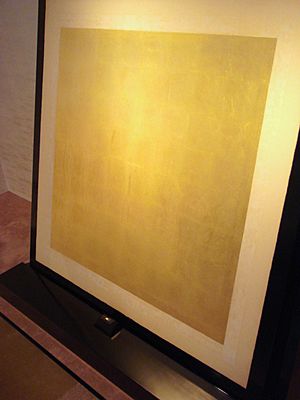Gold leaf facts for kids
Gold leaf is real gold that has been flattened into super-thin sheets. Imagine gold so thin it's almost like paper! This special process is called goldbeating. People often use gold leaf for something called gilding. Gilding means covering a surface with a thin layer of gold leaf to make it look shiny and valuable. The most common type of gold used for this is 22-karat yellow gold.
Contents
Gold Leaf in Art and Design
Gold leaf has been used for thousands of years to make art and objects look beautiful.
Decorating Artworks
Sometimes, gold leaf is used directly in art, not just to cover things. Many cultures used it to wrap special objects, like ancient bullae (small, hollow clay balls). It has also been a popular material in jewellery for a very long time.
Traditionally, gold leaf is a key material for gilding and adding sparkle to art or picture frames. In early Christian art, gold leaf was even used to create shiny backgrounds in mosaics. You can also see gold leaf in Buddhist art, where it decorates statues and symbols. Many religious and public buildings also have beautiful gold leaf on their domes and ceilings.
In Buildings
Gold leaf has a long history in architecture. For example, it was used in Byzantine and Roman churches and basilicas as early as 400 AD. It made these grand buildings look even more impressive and sacred.
Gold Leaf in Food
Did you know you can sometimes eat gold leaf? Yes, it's true! Gold leaf is sometimes used to decorate food or drink. You might find it on fancy desserts or confectionery (sweets). When gold is used as a food additive, it has a special code called E175. It doesn't have a taste, but it makes food look super luxurious and special.
Images for kids
-
Mille-feuille with some gold leaf in the Nishimuraya Hotel Shogetsutei from Kinosaki (Hyōgo Prefecture, Japan)
-
Ceiling of the Kumamoto Castle in Kumamoto (Kumamoto Prefecture, Japan)
-
Domes of churches from the Moscow Kremlin, covered with gold leaf
See also
 In Spanish: Pan de oro para niños
In Spanish: Pan de oro para niños










